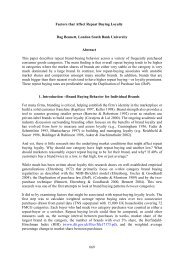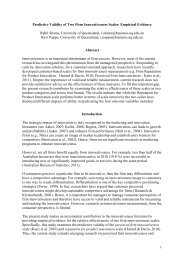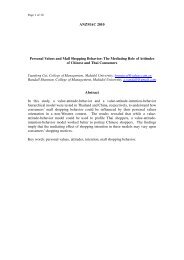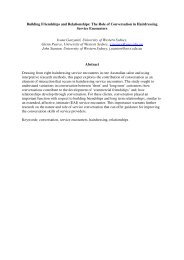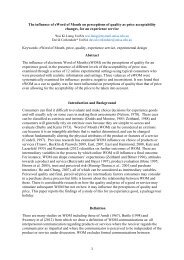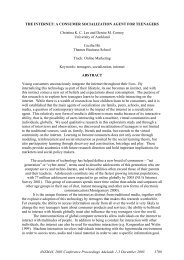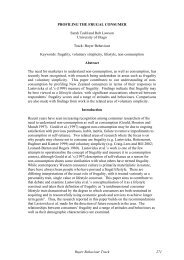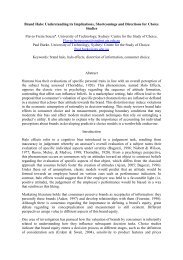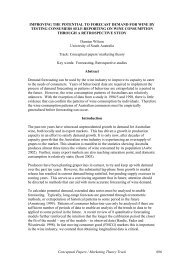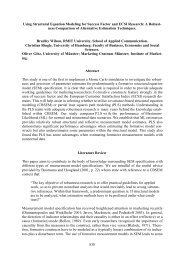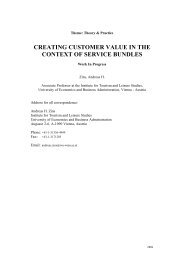A CONCEPTUAL MODEL OF TOURISM DESTINATION ...
A CONCEPTUAL MODEL OF TOURISM DESTINATION ...
A CONCEPTUAL MODEL OF TOURISM DESTINATION ...
Create successful ePaper yourself
Turn your PDF publications into a flip-book with our unique Google optimized e-Paper software.
Nevertheless the price tourists pay to visit and enjoy a destination experience has a<br />
role to play in determining the choice travellers make. TDCA is determined by both<br />
price and non-price factors. Given the evidence of price sensitivity of the travel<br />
demand, destinations need to monitor their price competitiveness relative to<br />
alternative destinations. Proposition 5 is derived, hence.<br />
P5. The ability of a destination to attract visitors and compete internationally is<br />
associated with its reputation and image and is moderated by the perceived cost of<br />
the experience.<br />
Outcomes of TDCA<br />
Pizam, Neumann and Reichel (1978) defined tourist satisfaction as ‘ the result of the<br />
interaction between a tourist’s experience at the destination area and the expectations<br />
he had about the destination’ based on the Expectations-disconfirmation paradigm.<br />
Tourist satisfaction is central in destinations as it determines tourist’s intention to<br />
revisit and recommend the destination to friends and relatives. Pizam and Ellis<br />
(1999), argue that tourist satisfaction can be used to measure competitive strengths<br />
and weaknesses by determining tourist perceptions of competitive choices.<br />
Destination attractiveness is related to perceived satisfaction (Ferrario 1979a; Pizam<br />
et al. 1978).<br />
Tourist destination image’s (TDI) importance is universally acknowledged as it affect<br />
people’s subjective perception, behaviour and the choice of a destination (Walmsley<br />
and Young 1998). Destination image is related to destination selection intention and<br />
tourist satisfaction. As such, image refers to the perceptions of tourists at a destination<br />
and these correspond to the perceived contribution of the different tourism services<br />
available, and consequently the destination experience. TDI is also related to<br />
destination positioning, competitive and strategic image (Ahmed and Krohn 1990)<br />
and is thus a concept that can help to explain competitiveness in tourism.<br />
Strategic management literature abounds with organisational performance measures<br />
like profitability, return on investment, return on assets, productivity of human<br />
resources, there has been a limited success in the attempt to come up with the<br />
measures of destination performance. For the overall destination performance, various<br />
statistical measures have been proposed. For example, total arrivals and the associated<br />
measures like the visitors (a) growth rate, average length of stay; (b) total destination<br />
and (c) employment created as measures of TDCA. More meaningful measures like<br />
net tourism receipts and the per capita net tourism receipts have also been proposed<br />
(Jayawardema and Ramajeesingh 2003).<br />
Conclusion<br />
Though there have been advances in modelling competitiveness in tourism there is<br />
little empirical evidence to support the models proposed by researchers. More<br />
importantly the dual perspective of TDCA has not been explored. The symmetrical<br />
approach to tourism destination evaluation should be a starting point in harmonising<br />
the interests of the destination as well as those of the tourists. The results of such an<br />
approach could be used to sell the destination interests to visitors as well as the<br />
interests of visitors to the destination operators. Researchers now need to move from<br />
conceptual to empirical validation of the proposed models. Initially the challenge<br />
should be to investigate the relationship between the identified variables and how<br />
strongly they influence the attractiveness and competitiveness of tourism destinations.<br />
The proposed model, as shown in Figure 1 can be tested using Structural Equation<br />
Conceptual Papers / Marketing Theory Track 644



